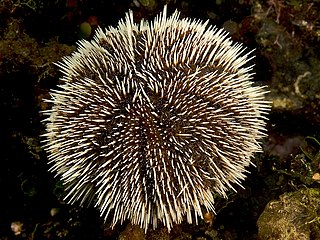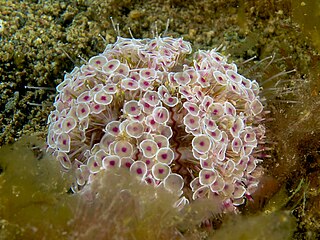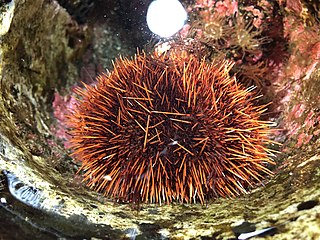
Coelopleurus is an extant genus of echinoids with fossil records dating back to the Eocene, with remains found in Europe and North America.

Cidaroida is an order of primitive sea urchins, the only living order of the subclass Perischoechinoidea. All other orders of this subclass, which were even more primitive than the living forms, became extinct during the Mesozoic.

Cidaridae is a family of sea urchins in the order Cidaroida.

Tripneustes is a genus of sea urchins belonging to the family Toxopneustidae.
Aporocidaris fragilis is a species of sea urchin of the family Ctenocidaridae. It is well-armoured with spines. It is placed in the genus Aporocidaris and lives in the sea. Aporocidaris fragilis was first scientifically described in 1907 by Alexander Emanuel Agassiz & Hubert Lyman Clark.

Toxopneustes is a genus of sea urchins from the tropical Indo-Pacific. It contains four species. They are known to possess medically significant venom to humans on their pedicellariae. They are sometimes collectively known as flower urchins, after the most widespread and most commonly encountered species in the genus, the flower urchin. Species included in the genus are the following:

Echinometra is a genus of sea urchins in the family Echinometridae.

Echinometra viridis, the reef urchin, is a species of sea urchin in the family Echinometridae. It is found on reefs in very shallow parts of the western Atlantic Ocean and the Caribbean Sea.
Austrocidaris canaliculata is a species of sea urchins of the family Cidaridae. Their armour is covered with spines. Austrocidaris canaliculata was first scientifically described in 1863 by Alexander Agassiz.

Centrocidaris is a monotypic genus of sea urchins belonging to the family Cidaridae. The only species is Centrocidaris doederleini. Their armour is covered with spines. Centrocidaris doederleini was first scientifically described in 1898 by Alexander Agassiz.
Chaetodiadema tuberculatum is a species of sea urchins of the Family Diadematidae. Their armour is covered with spines. Chaetodiadema tuberculatum was first scientifically described in 1909 by Hubert Lyman Clark.

The "raspberry sea urchin", Chondrocidaris brevispina, is a species of sea urchins of the Family Cidaridae. Their armour is covered with short, conical spines.

Chondrocidaris gigantea is a species of sea urchins of the Family Cidaridae. Their armour is covered with spines. Chondrocidaris gigantea was first scientifically described in 1863 by Alexander Agassiz.
Chorocidaris micca is a species of sea urchins of the Family Cidaridae. Their armour is covered with spines. Chorocidaris micca was first scientifically described in 1941 by Ikeda.

Cidaris blakei is a species of sea urchins of the family Cidaridae. Its armour is covered with spines of three types, one unique type being extended and fan-like, making it easily recognized. Alexander Agassiz first described it scientifically in 1878. It is present on the seabed in deep waters in the Gulf of Mexico and the Bahamas.

Toxopneustes roseus is a species of sea urchin from the East Pacific. It is sometimes known as the rose flower urchin or the pink flower urchin. Like the related flower urchin, they are venomous.

Araeosoma is a genus of deep-sea sea urchins in the family Echinothuriidae.
Tetragramma is a genus of fossil sea urchins known from the Upper Jurassic (Oxfordian) to the Upper Cretaceous (Turonian).

Dermechinus is a genus of sea urchin in the family Echinidae found in deep water in the southern Indian, Pacific and Atlantic Oceans. It is monotypic, with Dermechinus horridus, sometimes called the cactus urchin, being the only species.

Pseudocentrotus depressus, commonly known as the pink sea urchin, is a species of sea urchin, one of only two species in the genus Pseudocentrotus. It was first described in 1864 by the American marine zoologist Alexander Agassiz as Toxocidaris depressus, having been collected during the North Pacific Exploring and Surveying Expedition undertaken by Captain Cadwalader Ringgold and later Captain John Rodgers.

















